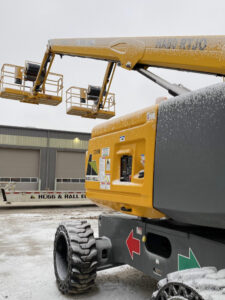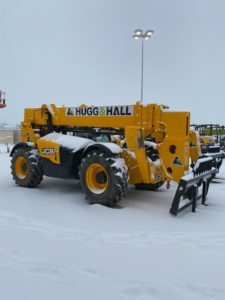
Winter Weather Safety
When winter weather strikes, it can damage your equipment and cause harm to your employees. Keep your employees safe in winter weather with these tips.
Want more information? Download our complete guide to winter construction site prep!
Personal Safety in Winter Conditions
Prevent slips, trips, and falls.

As temperatures approach the freezing point, it’s necessary for your company to help prevent slips, trips & falls. Thin patches of ice begin to occur when air temperatures reach the 30s and become dangerous quickly.
Proper PPE (Personal Protective Equipment) plays a significant role in keeping employees safe. Winter PPE includes non-slip footwear, gloves, jackets/coats, and hard-hat liners. This article from Construct Connect has additional information about winter PPE.
Even when your team has the appropriate PPE, equipment and ladders create additional jobsite hazards in winter. Conduct routine inspections for surface ice on your equipment. If you detect any snow or ice, clear the surface immediately and make sure your team’s footwear is free of snow and ice. As always, make sure your team is in their fall-protection gear for additional safety.
Recognize cold-related illness and act quickly.
Know the signs of hypothermia, frostbite, and trench foot and be prepared to administer first aid while you wait for emergency services. Your quick action can save a life.
Hypothermia
Early signs of hypothermia include shivering, loss of coordination, confusion, and fatigue. Prolonged hypothermia leads to blue skin, dilation of the pupils, lowered pulse rate, and a possible loss of consciousness.
If an individual on your team is experiencing the symptoms of hypothermia, alert the job supervisor and request medical assistance. Move the victim into a warm area. Remove any wet clothing and cover the victim with additional clothing or blankets. Warm beverages may help increase their body temperature. Once their body temperature has increased, keep them warm and dry.

Frostbite
Frostbite begins with a loss of feeling and color in affected areas, and can cause permanent damage to body tissue. It can even lead to limb amputation. Frostbite symptoms include reduced blood flow, numbness, tingling, stinging, and pale, waxy skin. The nose, ears, cheeks, chin, fingers, and toes are most commonly affected by frostbite.
If an employee is suffering from frostbite, take them to a warm area. The victim should avoid using the affected appendage and immerse it in warm—never hot—water. If no warm water is available, keep the affected area warm with body heat. Never rub the frostbitten area and do not expose it to direct heat.
Trench Foot
Trench foot is an injury caused by exposure to wet and cold conditions over a prolonged time. If the temperature is below 60°F and the worker’s feet are constantly wet, trench foot is a legitimate concern. Symptoms include discoloration, numbness, lower-body cramps, swelling, blisters, and subdermal bleeding.
To care for trench foot, remove the victim’s shoes and socks and dry their feet. Request medical attention. The victim should not try to walk, because walking can cause additional damage.
Provide heated break-spaces.
Taking breaks in heated areas and breaks for proper hydration are essential to winter safety. Encourage your employees to take time away from the elements. Breaks are also a convenient time to check for signs of cold-related illness.
To provide Your employees with a heated break area, check out these heaters. Make sure to properly vent the area and monitor for carbon monoxide exposure. Read our blog for more information on using heaters safely.
Put emergency kits in work vehicles.
Make sure each of your work trucks and vehicles have winter weather kits. Kits should include water, nutritious snacks, blankets, a flashlight, an ice scraper/snow brush, and more.
Now that you know the dangers of winter conditions & how to prepare for them, you will be better able to stay active and productive while keeping your employees safe in winter weather. For further preparation, we recommend keeping an updated calendar and having a set break system to keep your employees safe.
Interested in learning more about keeping your team safe and your equipment in tip-top shape? Download our complete Winter Prep Guide!
Want more winter weather tips and tricks? Check out our resources section!
Editor’s Note: This post was originally published in February 2021. We updated it for freshness, accuracy, and comprehensiveness in January 2023.
Back to News
Subscribe and unlock cutting-edge equipment insights, trends and tips!
Subscribe